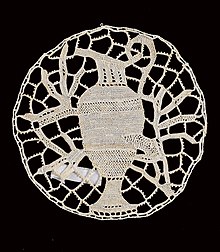Needle lace
[1] : 56–57 A second expert puts the development of needle lace in the following century, the 16th, in Italy, also stemming from embroidery, the openwork on linen technique called reticella.
[2] To show off their wealth in that period in Italy, the aristocracy favored wearing rich cloth embellished by embroidery and braid.
The needlework was dependent on remaining threads running vertically and horizontally, leaving squares and rectangles, which led to geometric designs.
In the 1500s, city officials decreed that young men in Venice were prohibited from lace wearing until they had turned 25.
[1]: 57–58 A variety of styles developed where the work is started by securing heavier guiding threads onto a stiff background (such as thick paper) with stitches that can later be removed.



